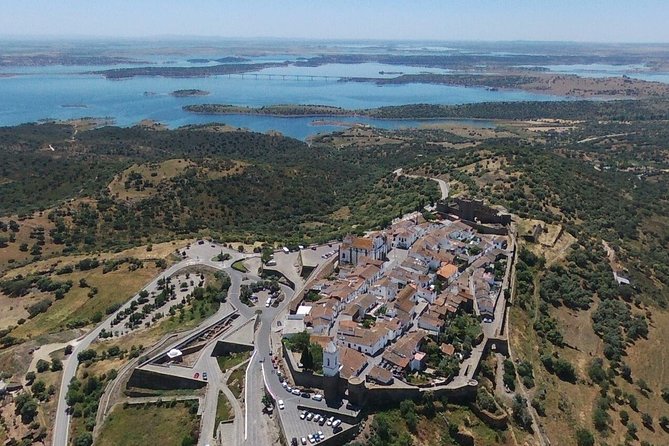
Private Tour Évora - Wine Tasting - Beautiful Medieval Village of Monsaraz
09am Leave direction to Alentejo, Cross the Bridge Vasco da Gama, the Biggest Bridge in Europe with 14 km , after it´s possible to see Vineyards, Cork Trees and one of typical Alentejo views, with many stork nests Approximately 2 hours trip to the first stop at the Ervideira for visit the Wine Cellar and tasting wines from 8 months of aging which come from the largest artificial lake in Europe ( Alqueva Lake ). After Lunch we Visit Village of Monsaraz one of the most tipycal Village in Portugal near the border of Spain, Monsaraz was reorganized during the Roman occupation, but later successively occupied by the Visigoths, Arabs, Mozarabs, Jews.
Back to Évora for visit to the City of Évora, Diana Roman Temple of Évora World Heritage, Giraldo Square, Church of San Francisco, Chapel of Bones,and Back to Lisbon
Options
Private Tour Évora - Wine Tasting - Beautiful Medieval Village of Monsaraz
Pickup included
What's included in Private Tour Évora - Wine Tasting - Beautiful Medieval Village of Monsaraz
(Subject to Option Inclusions)Itinerary
Templo Romano de Evora (Templo de Diana)
The Roman temple of Évora, known as the Temple of Diana, is located in the city of Évora, is part of the historical center of the city, which was classified as a World Heritage by UNESCO. Ranked as National Monument. It is one of the most famous landmarks of the city and one of the most significant symbols of the Roman presence in Portuguese territory.
Igreja De Sao Francisco
The Church of St. Francis in Evora is a church of Gothic-Manueline architecture. Built between 1480 and 1510 by masters of Pedraria Martim Lourenço and Pero de Trilho and decorated by the royal painters Francisco Henriques, Jorge Afonso and Garcia Fernandes, it is closely linked to the historical events that marked the period of maritime expansion of Portugal. This is evident in the symbols of the monumental nave of the vaulting vault: the cross of the Order of Christ and the emblems of the founding kings, D. João II and D. Manuel I. According to tradition, Gil Vicente was buried in this church in 1536.
Chapel of Bones
The Bones Chapel is one of the most famous monuments in Évora. It was built in the 17th century on the initiative of three Franciscan monks who, in the spirit of the time (religious counterrevolution, according to the norms of the Council of Trent), intended to convey the message of the transience of life, as can be seen from the famous warning at the entrance: "We bones here we are waiting for you." Besides the spiritual question, there was also a physical question, which is; there were in the region of Évora forty-two monastic cemeteries that were occupying too much space and strategic places that many intended to use for other purposes. So they decided to remove the skeletons from the earth and use them to build and decorate the chapel. Its walls and eight pillars are "decorated" with bones and skulls connected by brown cement. The vaults are of brick plastered to white, painted with allegorical motifs to death. It is a monument of a penitential architecture of ornate arches with rows of skulls, cornices and white ships. It has been calculated around five thousand bones, including skulls, vertebrae, femurs and others, coming from cemeteries, located in churches and convents of the city, and which were connected with brown cement and are arranged by the walls, ceiling, columns and even outside . There are still two whole skeletons hanging by chains on one of the walls, one of which is that of a child.
Inclusions
- Sockets USB for mobile phone charger
- Private tour
- Bottled water
- Wine tasting
- Tv with entertainment and films about the places to visit in your language
- Transport by air-conditioned minivan
- Free WIFI
- Lunch
- Gratuities
- Specialized infant seats are available
- Travelers should have at least a moderate level of physical fitness
- Children must be accompanied by an adult
- Dress code is smart casual
Meet
Pickup and Dropoff
Choose to be picked up from a list of locations
Additional Information
Hotel, Apartments, Villas, Port
Redeem
Ticket Redemption
• Dress code is smart casual Times are subject to change due to local traffic conditions.






